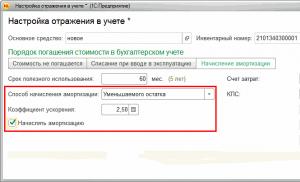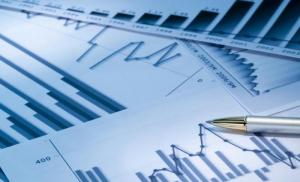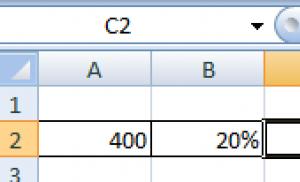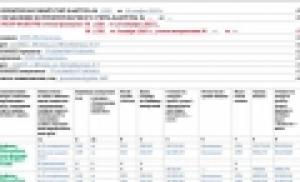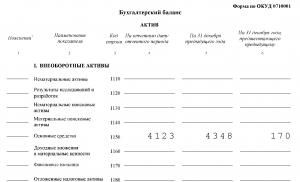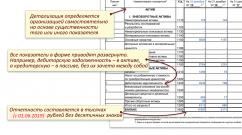Current liabilities include the total of the section. long term duties
The passive part of the balance sheet is represented by such elements as equity and liabilities of the enterprise as of the date of formation of the balance sheet. Both the equity and liabilities of the enterprise represent the sources of the organization's assets.
Long-term liabilities of the enterprise in the balance sheet
Long-term liabilities of the enterprise in the balance sheet are represented by such elements as:
- loans and credits of the organization;
- deferred tax liabilities;
- other long-term liabilities.
All long-term loans and credits that were granted to the organization are recorded on accounting account 67 "Long-term loans and loans" with an analytical breakdown by their types. Long-term are loans or credits with a maturity exceeding 12 calendar months. The credit balance of this account is an indicator in the company's long-term liabilities for loans and credits.
Deferred tax liabilities are also long-term liabilities of the entity. Such liabilities appear in the organization in the presence of tax permanent differences. Data on such differences are recorded on account 77 "Deferred tax liabilities".
Remark 1
If the organization has other long-term liabilities, then they are accounted for in the "Other long-term liabilities" line. For example, this could be a debt to suppliers for goods that has a maturity of more than one calendar year.
Short-term liabilities of the enterprise in the balance sheet
All short-term loans and credits that were granted to the organization are accounted for on accounting account 66 “Short-term loans and loans” with an analytical breakdown by their types. Short-term loans are loans or credits with a maturity of less than 12 calendar months. The credit balance of this account is an indicator in the composition of the company's short-term liabilities for loans and credits.
Accounts payable of an organization, as a rule, consists of several of its types and is accounted for in the corresponding accounts:
- 60 - debt to suppliers for goods or products received, if such products were received by the enterprise on the date of the balance sheet, but not paid;
- 62 - debt to buyers for the return of goods, if such claims for return were made as of the balance sheet date;
- 70 - debt to employees of the enterprise for the payment of wages and other payments. As a rule, at the end of the reporting period, organizations remain unpaid part of the wages for the second half of the last reporting month;
- 68 - debt to the budget for various taxes (value added tax, income tax, personal income tax, etc.). As a rule, organizations do not pay most of the taxes “in front”, therefore, at the end of the reporting period, such a debt appears;
- 69 - debt to off-budget funds (Pension Fund, Social Insurance Fund, etc.). As a rule, the amount of such debt is proportional to the amount of debt on unpaid wages.
Also, the organization may have other accounts payable, which is reflected in the line "Other creditors".
The balance sheet is a tabular version of the reflection of the financial performance of the organization on a specific date. In the most widespread form in the Russian Federation, the balance sheet consists of two equal parts, one of which shows what the organization has in monetary terms (balance sheet asset), and the other - from what sources it was acquired (balance sheet liability) . The basis of this equality is the reflection of property and liabilities in the way of double entry in accounting accounts.
ATTENTION! From 06/01/2019, changes have been made to the balance sheet form!
The balance sheet, drawn up on a certain date, allows you to assess the current financial condition of the organization, and the comparison of the data of the balance sheet, drawn up on different dates, allows you to trace the change in its financial condition over time. The balance sheet is one of the main documents that serve as a source of data for conducting an economic analysis of the enterprise.
Having trouble balancing? On our forum you can consult on any issue. For example, you can see if an explanatory note is needed for the financial statements of a small enterprise.
Classification of balance sheets
There are many types of balance sheet. Their diversity is determined by a variety of reasons: the nature of the data on the basis of which the balance sheet is formed, the time it was compiled, the purpose, the way the data is reflected, and a number of other factors.
According to the method of reflecting data, the balance sheet can be:
- static (balance) - drawn up on a specific date;
- dynamic (turnaround) - compiled by turnover for a certain period.
In relation to the time of compilation, balances are distinguished:
- introductory - at the beginning of activity;
- current - compiled as of the reporting date;
- liquidation - upon liquidation of the organization;
- rehabilitated - in the recovery of an organization approaching bankruptcy;
- dividing - when dividing an organization into several firms;
- unifying - when merging organizations into one.
According to the volume of data on organizations reflected in the balance sheet, balance sheets are distinguished:
- single - for one organization;
- consolidated - by the sum of data from several organizations;
- consolidated - for several interrelated organizations, the internal turnover between which is excluded when reporting.
By appointment, the balance sheet can be:
- trial (preliminary);
- final;
- predictive;
- reporting.
Depending on the nature of the source data, there is a balance:
- inventory (compiled according to the results of the inventory);
- book (compiled only according to credentials);
- general (compiled according to accounting data, taking into account the results of the inventory).
By way of displaying data:
- gross - with the inclusion of these regulatory items (depreciation, reserves, markup);
- net - with the exception of these regulatory articles.
Accounting balance sheets may vary depending on the organizational and legal form of the company (balance sheets of state, public, joint, private organizations) and on the type of its activity (main, auxiliary).
According to the periodicity, the balances are divided into monthly, quarterly, annual. They can be either full or abbreviated.
The balance sheet table can be of 2 types:
- horizontal - when the balance sheet is defined as the sum of its assets, and the sum of assets is equal to the sum of capital and liabilities;
- vertical - when the balance sheet is equal to the value of the net assets of the organization (ie, the amount of capital), and net assets, in turn, are equal to the assets of the enterprise minus its liabilities.
For internal purposes, the organization itself has the right to choose the frequency, methods and methods of compiling the balance sheet. Reporting submitted to the IFTS must have a certain form with comparable data as of the dates indicated in the balance sheet.
The structure of the balance sheet of the enterprise
The form of the balance sheet used for official reporting in the Russian Federation is a table divided into two parts: an asset and a liability of the balance sheet. The total assets and liabilities of the balance sheet must be equal.
The balance sheet asset is a reflection of the property and liabilities that are under the control of the enterprise, are used in its financial and economic activities and can bring benefits to it in the future. The asset is divided into 2 sections:
- non-current assets (this section reflects property used by the organization for a long time, the cost of which, as a rule, is taken into account in the financial result in installments);
- current assets, data on the presence of which are in constant dynamics, accounting for their value in the financial result, as a rule, is carried out one-time.
Read more about them in the article. "Current assets in the balance sheet are..." .
The liability of the balance characterizes the sources of those funds at the expense of which the asset of the balance is formed. It consists of three sections:
- capital and reserves, which reflect the organization's own funds (its net assets);
- long-term liabilities that characterize the debt of the enterprise, existing for a long time;
- short-term liabilities, showing an actively changing part of the organization's debt.
The allocation of sections in the structure of the balance sheet is due mainly to the temporary factor.
So, the balance sheet asset is divided into 2 sections depending on the time the assets are used in the organization's activities:
- non-current assets are used for more than 12 months;
- Current assets contain data on indicators that will change significantly over the next 12 months.
When allocating sections in the balance sheet liability, in addition to the time factor, the ownership of the funds at the expense of which the balance sheet asset is formed (own capital or borrowed funds) plays a role. Taking into account these 2 factors, the liability is formed from 3 sections:
- capital and reserves, where the organization's own funds are divided into a practically constant part (authorized capital) and a variable, depending both on the adopted accounting policy (revaluation, reserve capital) and on the monthly changing financial result of activity;
- long-term liabilities - accounts payable that will exist for more than 12 months after the reporting date;
- short-term liabilities - accounts payable, significant changes in which will occur within the next 12 months.
The concept and meaning of balance sheet items
The sections of the balance sheet are detailed by breaking them down into articles. The itemization recommended for submission to the IFTS is contained in the balance sheet forms approved by order of the Ministry of Finance of Russia dated July 2, 2010 No. 66n in 2 versions:
- complete (Appendix 1);
- abbreviated (Appendix 5).
From 06/01/2019, the balance sheet form is valid as amended by the order of the Ministry of Finance dated 04/19/2019 No. 61n. The key changes in it (as well as in other reporting) are as follows:
- now reporting can only be done in thousand rubles, millions can no longer be used as a unit of measurement;
- OKVED in the header has been replaced by OKVED 2;
- in the balance sheet, information about the audit organization (auditor) must be indicated.
The mark about the auditor should be put only to those firms that are subject to mandatory audit. The tax authorities will use it both to impose a fine on the organization itself if it ignored the obligation to undergo an audit, and in order to know from which auditor they should request information on the organization in accordance with Art. 93 of the Tax Code of the Russian Federation.
More significant changes have taken place in form 2. For more information about them, see here.
The abbreviated (simplified) form of the balance sheet allows the combination of its items in order to obtain consolidated indicators and simplify reporting. However, its application is available only to persons who have the right to conduct simplified accounting (SMEs, NPOs, participants in the Skolkovo project).
The breakdown of sections into articles is due to the need to highlight the main types of property and liabilities that form the corresponding sections of the balance sheet.
- fixed assets:
- intangible assets;
- research and development results;
- Intangible search assets;
- material prospecting assets;
- fixed assets;
- profitable investments in material values;
- financial investments;
- Deferred tax assets;
- Other noncurrent assets;
- current assets:
- reserves;
- VAT on purchased assets;
- accounts receivable;
- financial investments (excluding cash equivalents);
- cash and cash equivalents;
- Other current assets;
- capital and reserves:
- authorized capital (share capital, authorized fund, contributions of comrades);
- own shares purchased from shareholders;
- revaluation of non-current assets;
- additional capital (without revaluation);
- Reserve capital;
- retained earnings (uncovered loss);
Find out which line shows gross profit on the balance sheet. .
- long term duties:
- borrowed funds;
- deferred tax liabilities;
- estimated liabilities;
- other obligations;
- short-term obligations:
- borrowed funds;
- accounts payable;
- revenue of the future periods;
- estimated liabilities;
- other obligations.
When compiling a balance sheet, an organization can use the itemization recommended by the Ministry of Finance of Russia. However, it has the right to apply its own development of this breakdown, if it believes that this will lead to greater reliability of reporting. In addition, in the absence of data to fill in the relevant items, the firm has the right to exclude such items from the balance sheet it draws up.

The composition of the balance sheet items
Balance sheet items are filled in on the basis of data on balances on accounting accounts as of the reporting date. When filling out a report for submission to the Federal Tax Service Inspectorate, you must be guided by a number of rules established for the preparation of such reports (PBU 4/99, approved by order of the Ministry of Finance of Russia dated July 6, 1999 No. 43n):
- The initial credentials must be true, complete, neutral and formed in accordance with the rules of the current PBU. When reflecting them, it is necessary to observe the principles of materiality and comparability with the results of previous periods.
- In the current report, the data of previous periods must correspond to the figures of the final reporting for these periods.
- For the annual balance, the presence of property and liabilities must be confirmed by the results of their inventory.
- Debit and credit balances in the balance sheet do not collapse.
- Fixed assets and intangible assets are shown at residual value.
- Assets are recorded at their book value (net of created reserves and markup).
From 06/01/2019, the accounting balance is filled only in thousands of rubles (without decimal places).
Below is information on the basis of the balances on which accounts the above balance sheet items are filled in with respect to the current version of the chart of accounts of accounting, approved by order of the Ministry of Finance of Russia dated October 31, 2000 No. 94n:
- The article “Intangible assets” indicates the residual value of intangible assets corresponding to the difference in the balances of accounting accounts 04 and 05. At the same time, for account 04, data falling into the line “Research and development results” are not taken into account, and for account 05 - figures related to intangible search assets.
- The item “Results of research and development” is filled in if there is data on R&D costs on account 04.
- Data on the items "Intangible Exploration Assets" and "Tangible Exploration Assets" are important only for those organizations that develop natural resources if they have information on account 08 to fill in the lines for these articles. Tangible prospecting assets include tangible objects, and intangible - all the rest. Both types of assets are subject to depreciation, accounted for respectively in accounts 02 and 05.
- For the item “Fixed assets”, the data on the residual value of fixed assets (the difference in the balances of accounting accounts 01 and 02, while account 02 does not take into account data related to tangible exploration assets and profitable investments in material values) and capital investment costs (account 08, with the exception of the figures that fell into the lines of the articles "Intangible exploration assets" and "Tangible exploration assets").
- The data for the article "Profitable investments in financial assets" are taken as the difference between the balances of accounts 03 and 02 in relation to the same objects.
- The article “Financial investments” in non-current assets is filled in if there are amounts with a maturity of more than 12 months on accounts 55 (deposits), 58 (financial investments), 73 (loans to employees). The balance of account 58 is reduced by the amount of the created reserve (account 59) relating to long-term investments.
- Under the article “Deferred tax assets”, organizations applying RAS 18/02 indicate the balance of account 09.
- When the line of the article “Other non-current assets” is used, it reflects in the balance sheet assets that either do not fall into the above lines, or those that the organization considers it necessary to allocate.
- The figure for the item "Stocks" is formed as the sum of balances on accounts 10, 11 (minus the reserve recorded on account 14), 15, 16, 20, 21, 23, 28, 29, 41 (minus account 42, if the accounting of goods conducted with an extra charge), 43, 44, 45, 46, 97.
- The article "VAT on acquired values" reflects the balance of account 19.
- To obtain the data indicated under the item "Accounts receivable", the debit balances on accounts 60, 62 (both accounts minus reserves formed on account 63), 66, 67, 68, 69, 70, 71, 73 (minus data accounted for under the item “Financial investments”), 75, 76.
- Under the item “Financial investments (excluding cash equivalents)”, current assets show data on accounts 55 (deposits), 58 (financial investments), 73 (loans to employees) with maturities of less than 12 months. At the same time, the figures on account 58 are reduced by the amount of the created reserve (account 59) for short-term investments.
- Data for the item "Cash and cash equivalents" are obtained by adding the balances of accounts 50, 51, 52, 55 (excluding deposits), 57.
- The line of the article “Other current assets” includes assets, either for some reason not reflected in the above lines, or those that the organization considers it necessary to allocate. For example, this may be a bad debt of a counterparty or the value of stolen property, in respect of which investigative actions have not yet been completed. The reflection of such data on this line with a corresponding decrease in figures for those articles in which they could be reflected if there were no decision of the organization to allocate them, will require notes both to the article “Other current assets” and to the second article, which will be affected by such an operation.
- Data for the article "Authorized capital (share capital, authorized fund, contributions of comrades)" are taken as the balance of account 80.
- The figures in the item “Own shares repurchased from shareholders” correspond to the balances on account 81.
- For the article “Revaluation of non-current assets”, data on the balances on account 83 relating to fixed assets and intangible assets are used.
- Data on the item "Additional capital (without revaluation)" is formed as the balance on account 83 minus data on the revaluation of fixed assets and intangible assets.
- The article "Reserve capital" shows the balance of account 82.
- The value reflected in the item “Retained earnings (uncovered loss)” in the annual balance sheet is the balance of account 84. For interim reporting (before the reformation of the balance sheet carried out at the end of the year), this figure consists of two balances: account 84 (financial result of previous years) and 99 (financial result of the current period of the reporting year). The item "Retained earnings (uncovered loss)" is the only balance sheet item that can have a negative value. At the same time, it is important that the result of the section “Capital and reserves” (net assets) for an organization that has a loss does not turn out to be less than the amount of the authorized capital. If this circumstance takes place for two consecutive financial years, then the organization must either reduce its authorized capital to the appropriate figure (and this is not always possible, since the authorized capital cannot be less than the minimum value established by the current legislation), or it is to be liquidated.
Read more about the reform of the balance sheet in the article. “How and when to reform the balance sheet?” .
- The item "Borrowed funds" in the section "Long-term liabilities" is filled in if there is debt on loans and borrowings, the maturity of which exceeds 12 months (balance on account 67). At the same time, interest on long-term borrowed funds should be included in short-term accounts payable.
- Under the article "Deferred tax liabilities", organizations applying PBU 18/02 indicate the balance of account 77.
- The value under the item "Estimated liabilities" in the section "Long-term liabilities" corresponds to the balance of account 96 (reserves for future expenses) in terms of those reserves, the period of use of which exceeds 12 months.
- Under the article "Other liabilities" in the section "Long-term liabilities" are shown liabilities with a maturity of more than 12 months, not included in other lines of long-term liabilities.
- The item "Borrowed funds" in the section "Current liabilities" is filled in if there is debt on loans and borrowings, the maturity of which is less than 12 months (balance on account 66). At the same time, this includes interest on long-term borrowed funds recorded on account 67, and debt on long-term loans and borrowings recorded on account 67, if less than 12 months are left before its repayment.
- Data for the item "Accounts payable" are formed as the sum of credit balances on accounts 60, 62, 68, 69, 70, 71, 73, 75, 76.
- For the item “Deferred income”, the value is taken as the sum of balances on accounts 86 (targeted financing) and 98 (deferred income).
- The value under the item "Estimated liabilities" in the section "Current liabilities" corresponds to the balance of account 96 (reserves for future expenses) in terms of those reserves, the period of use of which is less than 12 months.
- Under the article “Other liabilities”, the section “Current liabilities” shows liabilities with a maturity of less than 12 months that are not included in other lines of short-term liabilities.
Other non-current assets - what is it in the balance sheet?
“Other non-current assets” - in the balance sheet, these are, as already mentioned, non-current assets that are not reflected in other lines of section 1 “Non-current assets”.
Other non-current assets of the organization may include, for example:
- investments in non-current assets of the organization recorded on the relevant sub-accounts of account 08 "Investments in non-current assets", in particular, the organization's costs for objects that will subsequently be taken into account as objects of intangible assets or fixed assets, as well as costs associated with the implementation of unfinished R&D, if the organization does not reflect these indicators;
- equipment for installation (equipment requiring installation), as well as transportation and procurement costs related to it, reflected in accounts 15 and 16;
- a one-time lump-sum payment, provided that the write-off period for these expenses exceeds 12 months after the reporting date or the duration of the operating cycle, if it exceeds 12 months;
- the amount of the listed advances and advance payment for works, services related to the construction of fixed assets.
Current liabilities in the balance sheet is line 1500 of the balance sheet
Often, accountants, when filling out tables characterizing the financial condition of an organization, face difficulties when it is required to indicate current liabilities, because this concept is absent in regulatory documents on accounting and taxation.
To determine where current liabilities are reflected in the balance sheet, let's turn to the meaning of this term. The Financial Dictionary defines current liabilities as accounts payable due within the next 12 months. In other words, current liabilities are synonymous with short-term liabilities. Short-term liabilities are reflected in section V of the liabilities side of the balance sheet. Thus, the current liabilities in the balance sheet are line 1500 “Total for section V”, which is defined as the sum of lines 1510, 1520, 1540, 1550, 1530 of the liabilities of the balance sheet.
Find out when the balance sheet is submitted (terms, nuances). .
Results
The balance sheet is the main component of the financial statements, a summary of the organization's financial indicators as of a certain date. It is drawn up in a certain form and according to certain rules. It is rented to the tax office and also presented to other interested users. Starting from June 1, 2019, you must use the form as amended on 04/19/2019.
Each organization has assets and liabilities, which, in turn, are divided into long-term and current. If the former influence the prospects for the development of the company as a whole, then the latter have an impact on the situation in the reporting period. Let's deal with them in more detail.
The resources of the organization that are directly involved in the turnover and are able to bring the company income for a short time are called current assets. Since such resources are very mobile (as can be seen even from their name), they need to be given special attention in accounting. Moreover, current assets are a separate group in the company's balance sheet, and the balance must be correctly indicated for all accounts that are included in it. Based on these data, the liquidity ratio is usually determined.
What is considered a company's current assets?
Assets are called all property belonging to the subject of economic activity. In particular, these are:
- financial resources (cash, securities);
- material resources (goods, materials, fixed assets);
- intangible resources (patents, copyrights).
All these resources are conditionally divided into several categories. For example, according to the speed of circulation, they can be divided into:
- having the maximum degree of liquidity (cash, securities);
- quickly realizable (inventory, working capital, receivables with a short maturity);
- slowly realizable (long-term receivables);
- hard-to-sell resources (fixed assets, intangible assets).
Thus, all current assets of the organization from the first two points of this list can be attributed to current assets, because they have a fairly high degree of liquidity, which means that they are directly involved in the production cycle. More accurate information can be obtained from paragraph 19 PBU 4/99, in which the short-term resources of the organization include those whose circulation period is not more than 12 months after the reporting date or the duration of the operating cycle is more than 12 months. Other resources are recognized as long-term. The latter are also called non-current, since they usually do not participate in the production process and do not affect the turnover of the organization.
Accounting
Since, in fact, all the property of the company has a heterogeneous composition, it is taken into account on different accounts of the accounting chart of accounts approved by order of the Ministry of Finance of the Russian Federation of October 31, 2000 No. 94n (as amended on November 8, 2010). In particular, for this purpose, such accounts are used as:
- 50 "Cashier";
- 51 "Settlement account" (and 52 "Currency account");
- 58 "Financial investments";
- 10 "Materials";
- 41 "Goods";
- 62 "Settlements with buyers and customers";
- and others similar, which are located in the sections "Inventory", "Cash", "Finished products and goods", "Settlements".
Liabilities are also classified as assets under turnover, as they are in essence already invested money owned by the firm. All these accounts are grouped in the balance in several lines, and in order to determine what to enter in each of them, a special formula is applied.
Balance
The most complete property status of the organization shows the balance sheet. In the form approved by order of the Ministry of Finance dated July 2, 2010 No. 66n, the following composition of the organization's current assets is defined:
All these data are summarized on line 1200.
Current Assets: Formula and Liquidity
Current assets in the balance sheet (line 1200) include receivables, which, as you know, can be not only short-term (current), but also long-term. Therefore, in order to obtain the net composition of working capital according to the balance sheet, it is necessary to apply a special formula. There is nothing complicated in this, it is enough just to know the exact amount of long-term receivables according to accounting data. Then the formula will look like this:
The amount of current assets on the balance sheet = Amount on line 1200 - Long-term receivables.
After this value is found, you can proceed to the definition of the liquidity ratio of working capital. This is a very important indicator that indicates the economic situation of the company. It makes it possible to determine the company's ability to quickly pay off its obligations at the expense of its own working capital. Therefore, if the coefficient is higher than one, then things are going well, and the company is able to pay off its debts. But if it is low, especially below one, the owners have something to think about. Indeed, in this case, the obligations exceed the property of the company, and this is an unfavorable sign.
In addition to the already known indicators, in order to determine the liquidity of current assets, it is necessary to know the data indicated in the company's balance sheet by:
- line 1510 "Borrowed funds";
- line 1520 "Accounts payable";
- line 1550 "Other liabilities".
If all the data is available, we calculate the liquidity ratio using the formula:
Ratio = Current assets on the balance sheet / Current liabilities on the balance sheet (the sum of lines 1510, 1520 and 1550).
There is, however, one important feature. When summing liabilities, it is also desirable to take into account only short-term liabilities in order to get a reliable picture of the state of affairs with liquidity.
Current liabilities of the enterprise name the real debt of the organization that exists at the reporting date. Their repayment entails an outflow of cash resources and a decrease in benefits. Consider further the composition and features current liabilities.
General information
Current responsibility- debt arising as a result of transactions or economic transactions in the past. They can be short or long term.
Short-term current liabilities repaid within or 1 year. All other debt is long-term.
Accounting features
Operations for obtaining and repaying short-term loans are reflected in account. 3010-3020. Analytics is conducted for each type of loan, individual lenders.
Overdraft, which is a type of short-term loan, provided in excess of the balance of the account, as well as loans outstanding on time, are shown separately.

Degree of solvency on current liabilities
It is determined during the audit. The objectives of the audit are to form an opinion by a specialist about:
- The state of accounting and on-farm control over the legality of the debt.
- Correct accounting of settlement transactions, including those related to the payment of taxes.
- Timeliness of repayment current liabilities.
During the audit, the following is carried out:
- Checking the correctness of the primary documentation. It serves as the basis for accounting current liabilities.
- Checking analytical, synthetic accounting, their relationship.
- The correctness of transferring information to the general ledger and reporting, the use of appropriate accounts.
- Evaluation of the organization of internal control of settlement operations for debt repayment.
- Checking the classification of liabilities, the availability of relevant explanations in the notes to the financial statements.
- Evaluation of the effectiveness of the use of credit funds.

Audit Objects
When checking current liabilities, debts for:
- settlements with suppliers, customers, contractors, buyers;
- off-budget allocations;
- settlements with municipal and state bodies;
- social insurance;
- budgeting;
- wages;
- settlements with founders;
- on-farm operations;
- settlements with banks.
Auditor Objectives
During the verification process, the specialist must determine:
- The directions in which the borrowed funds were spent, the compliance of these goals with the terms of the contract.
- Composition of security or guarantees.
- Timeliness and completeness of repayment.
- Accuracy of interest payments.
- Validity and legality of obtaining loans from other entities.

The auditor should also check:
- Whether interest paid has been expensed in the current period.
- Whether the "Current Part" items are included in the current liabilities section.
- Whether the indicators for overdraft items are correctly determined.
During the audit, the specialist determines whether financial discipline is observed at the enterprise. Based on the results of the audit, recommendations are developed to improve the situation.
Analyzing the company, the auditor needs to pay attention to a number of significant points:
- Are there any supply contracts (works, services), are they properly drawn up.
- If there is a debt, the date and reason for the occurrence should be determined.
- Are there obligations that have expired.
- When accepting inventory items for which no settlement documents have been received, you should check whether these items are reflected in the number of paid items, but in transit, or not taken out of the suppliers' warehouses.
- Whether an inventory of settlement transactions was carried out. If necessary, verification is carried out.
- Whether material assets are fully capitalized. For verification, information on the number and cost of objects is compared with the data of receipt documents (waybills, invoices) and indicators taken from the analytical accounting of settlement transactions with suppliers, as well as from inventory books.
- Are the prices of material assets correctly determined, do they correspond to the value specified in the supply contracts.
- Are the costs written off correctly?
- Have suppliers been penalized for non-compliance?
- Whether the debts with expired terms are written off correctly.
- Have any complaints been sent to suppliers/contractors about discrepancies in tariffs and prices, including when making arithmetic errors, quality with technical conditions and standards, as well as for downtime and marriage caused by the fault of contractors/suppliers.
- When analyzing settlement operations, it should be established whether material values are provided by a source of financing, whether design estimates for structures under construction have been drawn up, whether there are additions in the volume of work performed.
- Are the synthetic and analytical records correctly maintained?
- Does the information of the order journal No. 3 correspond to the information given in the balance sheet and the General Ledger.
- Are the accounting entries for settlement accounts correct?

The nature of the debt
On this basis, current liabilities are divided into normal and unjustified.
The former include debt due to economic necessity. For example, it can be a loan for equipment modification.
Unjustified debt is called overdue obligations to the budget, payroll personnel, suppliers on settlement documents not repaid on time, etc. Its presence indicates a low solvency of the enterprise. If no action is taken, this situation can lead to bankruptcy.
Debt indicators
The status of liabilities at the beginning and end of the reporting period is characterized by the balances of the following items:
- Financial short-term liabilities.
- Tax debt.
- Liabilities for other payments.
- Short-term accounts payable and estimated liabilities.
- Other short-term debt.
Current liability ratio
The calculation of the amount of debt is carried out according to the following equation:
TO \u003d ZS + KZ + ON, in which:
- current liabilities - TO;
- borrowed funds - AP;
- accounts payable - KZ;
- other liabilities - software.
To assess the degree of solvency, the coverage ratio of liabilities at the expense of only current assets is used. It is calculated by dividing assets by short-term current liabilities. The higher the indicator, the higher the solvency, respectively.

The formula looks like this:
K = current assets / current liabilities.
This equation is general. In practice, a formula is also used that allows you to calculate by groups of liabilities and assets:
K \u003d (A1 + A2 + A3) / (P1 + P2), wherein:
- A1 - the most liquid assets.
- A2 - fast-acting means.
- A3 - slow-moving assets.
- P1 - the most urgent debt.
- P2 - short-term liabilities.
The normal value of the coefficient is considered to be 1.5-2.5. The specific value is set depending on the economic sector. An indicator less than one indicates a high financial risk. This suggests that the company cannot repay its obligations properly and on time. If the coefficient value exceeds 3, then the capital structure is organized irrationally. Part of the funds is not involved in the turnover.
Section V "Current liabilities" reflects the amounts of accounts payable payable within 12 months after the reporting date. line 610 "Loans and credits" reflects the amount of the organization's debt on received short-term loans and borrowings recorded on account 66 "Short-term loans and borrowings", taking into account interest due at the end of the reporting period. line 620 "Accounts payable" the amount of the balance on accounts 60, 62 is reflected in the sub-account "Advances received", 70, 71, 68, 69, 76.
Separate lines of the balance reflect: - according to line "Suppliers and contractors"- the amount of debt to suppliers and contractors for received material assets, work performed, services rendered to the organization. This item also reflects the debt to suppliers for uninvoiced deliveries; line "Debt to the personnel of the organization"- accrued but not yet paid amounts of wages; line "Debt to state non-budgetary funds"- the amount of debt on deductions for state social insurance, pensions and medical insurance of employees of the organization; line "Debt on taxes and fees"- the amount of the organization's debt to the budgets of all levels for taxes, fees, including personal income tax; line "Other creditors"- the amount of the organization's debt for settlements, data on which are not reflected in other lines of the balance sheet item "Accounts payable", namely: debt to buyers and customers for advances received from them; the organization's debt on payments for compulsory and voluntary insurance of property and employees of the organization and other types of insurance; the amount of obligations of the lessee organization for fixed assets transferred to it under the terms of a long-term lease; debt on deductions to extra-budgetary funds and other special funds (except for the funds indicated above); debt on bank loans received by the organization for issuing loans to employees for individual housing construction, for the construction of garden houses and other purposes, as well as for reimbursement to trade organizations of amounts for goods sold by them on credit. excessively transferred amounts of taxes are shown under the relevant items "Accounts receivable" in the section "Current assets" of the balance sheet. Line 630 "Debt to the participants (founders) for the payment of income" is intended to reflect the amount of the organization's debt on dividends due on shares or interest on income from participation in the authorized capital, recorded on a separate sub-account to account 75 "Settlements with the founders." line 640 "Deferred income" shows the amounts accounted for in accordance with the accounting rules as deferred income on account 98 “Deferred income”.
In particular, the article "Deferred income" reflects the balances of the amounts of targeted financing received by a commercial organization (from the budget, from other organizations and citizens). Line 650 "Reserves for future expenses" is intended to reflect the balances of funds reserved by the organization in accordance with the Regulation on accounting and financial reporting in the Russian Federation. These reserves are formed only in accordance with the accounting policy. Depending on the specifics of the organization and the reserves created, they can be left for the next year and continue to form further. If, when adjusting the accounting policy for the next reporting year, the organization considers it inappropriate to accrue reserves for future expenses, then the balances of the reserves, for which there are carry-over balances in the prescribed manner, as of January 1 of the next year, are subject to joining the financial result of the organization with reflection in accounting organizations for January. Short-term liabilities that are not reflected in the previous lines of this section are reflected in the balance sheet at line 660 "Other current liabilities".Line 690 is the total for section V and is determined by summing lines 610, 620, 630, 640, 650 and 660. Line 700 represents Balance, i.e. the sum of the totals of sections III, IV and V. With the correct completion of the balance sheet, lines 300 and 700 should be equal. The balance sheet report contains "Certificate on the availability of valuables recorded on off-balance accounts". In it on the line "Leased fixed assets" the debit balance is reflected on account 001, which takes into account fixed assets received on lease, in the assessment determined by the agreement. A separate line highlights objects received under leasing, in the event that under the terms of the agreement the ownership is with the lessor. On the line "Commodity and material assets accepted for safekeeping" the debit balance on account 002 is reflected. It reflects inventory items that are in safe custody if they are received under an agreement under the terms of which the moment of transfer of ownership has not yet arrived, or if these are sold goods or products for which ownership has already passed to the buyer, but they were left in the supplier's warehouse for safekeeping until export. Line "Goods accepted for commission" contains information about the goods accepted for commission, reflected on account 004. This line reflects the accounting data of those organizations that are engaged in commission trade or fulfill agency agreements or agency agreements. On the line "Debt written off at a loss of insolvent debtors" the debt accounted for the balance on account 007 is reflected. The period of accounting for the write-off debt off the balance sheet is 5 years, during which it is “monitored” with attempts to collect it. After 5 years, the write-off of such debt is issued by an accounting statement with a reflection on the credit of account 007.
Line "Securities for obligations and payments received" is designed to account for the amount of guarantees received by the organization to ensure the fulfillment of obligations and payments. This may be a bank guarantee or a guarantee issued by a third party. Accounting is kept on account 008 while providing analytics. Line "Securing Obligations and Payments Issued" is used to record the amount of guarantees issued to a third party to ensure the fulfillment of payments and obligations. Accounting is kept on account 009 for each guarantee. Line data "Depreciation of the housing stock" reflect the amount of depreciation accrued on the housing stock, formed on account 010. On the line "Depreciation of objects of external improvement and other similar objects" the depreciation of external improvement objects that are on the balance sheet of the organization is reflected.
Liabilities in the balance sheet
Definition
Liabilities ( English Liabilities) are one of the three sections of the balance sheet other than assets and equity. This section reflects the debt obligations of the company to its creditors, which arose as a result of previous operations. In their economic essence, they, like equity, are a source of financing for the company's assets. In case of non-fulfillment of debt obligations, creditors have the right to claim the company's assets within the framework of the debt outstanding to them.
Liabilities also include advances received that were made for future goods, works or services. Since this amount has not yet been earned, it may be shown as deferred income or customer deposits.
The structure of liabilities in the balance sheet
Liabilities have the same classification structure as assets: current liabilities and long-term liabilities. In the balance sheet, they are reflected in the order of increasing maturity of their payment.
Current responsibility
Liabilities that must be paid within 12 months or the operating cycle if its duration is more than one year are considered current.
Their occurrence is usually associated with the use of current assets (eng. Current Assets), the creation of another current obligation or the provision of any services.
Typically, this section of the balance sheet includes the following items.
- Debt to banks. Represents the amount of short-term debt to banks, for example, under a bank credit line.
- Accounts payable. This is the amount of debt to suppliers of products and services that were provided on credit, but the payment due date for which has not yet come.
- Wages, rents, taxes and utilities payable. It reflects the amounts that the company must pay to its employees, landlords, government, etc.
- Accrued liabilities (accrued expenses). These obligations arise as a result of the fact that the costs arise in the period preceding the period of their payment. This item covers a wide variety of expenses, for example, advances received from customers, dividends payable, payroll arrears, etc.
- Bills payable (short-term loans). These are the amounts that the company is obligated to pay to the creditor, which usually also involves the payment of interest.
- Deferred income (customer prepayment). These are payments received from customers for goods and services that the company has not yet provided or has not begun to incur any costs associated with their provision.
- Dividends payable.
It occurs in a situation where the company has already declared dividends, but has not yet paid them to its owners.
- Current portion of long-term debt. This item reflects the portion of long-term debt that is due within the next 12 months. In theory, any associated premium or discount should also be classified as a current liability.
- Current portion of finance lease liabilities. This is part of the long-term finance lease payments that are due within the next year.
long term duties
Long-term liabilities are liabilities that must be repaid later than 12 months later or after the operating cycle if it is longer than one year. They should be recorded as the present value of future payments.
The most common examples of long-term liabilities are.
- Bills payable (long-term loans). This is the amount that the company is obligated to pay to the creditor, which is usually accompanied by the payment of interest.
- Long-term debt (bonds payable). This is long-term debt minus the current portion.
- Deferred tax liabilities. They arise as a result of discrepancies between accounting and tax accounting standards in the case when the amount of tax payable in accounting exceeds the amount of tax payable in tax accounting. In other words, this is the amount of tax that the company will have to pay in the future.
- Employee retirement plan. These are the obligations of the company to pay pensions to its retired and current employees. Payments from this fund begin from the moment the employee retires. This item reflects the additional amount that the company must contribute to the current pension fund in order to meet its future pension obligations.
- Long-term financial lease obligations.
Contra accounts in liabilities
Liability accounts are passive and have a credit balance. However, to correct some of them, counter, in this case, counter-passive accounts are used, which have a debit balance, that is, they reduce the amount of obligations. An example of such accounts is a discount on bonds payable or a discount on promissory notes payable.
intentions
Obligatory intentions of a company, such as signing a contract to receive goods or services in the future, while legally binding, are not reflected in the balance sheet until they are actually delivered. If the amounts of such intentions are material, they are disclosed in the notes to the financial statements.
Contingent liabilities
Contingent liabilities ( English Contingent Liabilities) are potentially possible obligations, the transformation of which into real depends on the development of certain events in the future. The most common examples of such liabilities are warranties and legal claims against the company.
It is necessary to reflect contingent liabilities in the balance sheet when there is a significant probability of their conversion into real liabilities and their amount can be accurately estimated. If the probability is insignificant, then they should not be reflected in the balance sheet or in the notes to the financial statements. Intermediate states should be disclosed in the notes to the financial statements.
